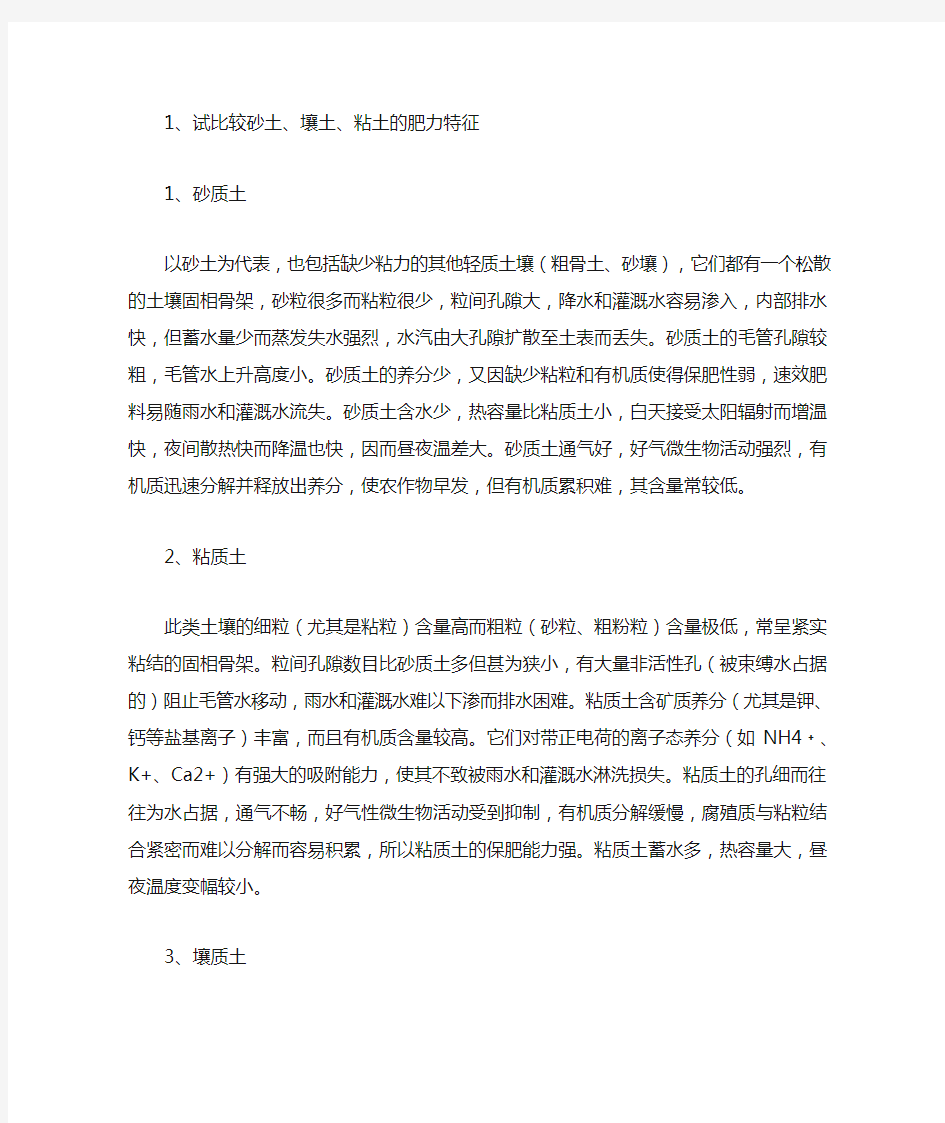砂土、壤土、粘土的肥力特征


1、试比较砂土、壤土、粘土的肥力特征
1、砂质土
以砂土为代表,也包括缺少粘力的其他轻质土壤(粗骨土、砂壤),它们都有一个松散的土壤固相骨架,砂粒很多而粘粒很少,粒间孔隙大,降水和灌溉水容易渗入,内部排水快,但蓄水量少而蒸发失水强烈,水汽由大孔隙扩散至土表而丢失。砂质土的毛管孔隙较粗,毛管水上升高度小。砂质土的养分少,又因缺少粘粒和有机质使得保肥性弱,速效肥料易随雨水和灌溉水流失。砂质土含水少,热容量比粘质土小,白天接受太阳辐射而增温快,夜间散热快而降温也快,因而昼夜温差大。砂质土通气好,好气微生物活动强烈,有机质迅速分解并释放出养分,使农作物早发,但有机质累积难,其含量常较低。
2、粘质土
此类土壤的细粒(尤其是粘粒)含量高而粗粒(砂粒、粗粉粒)含量极低,常呈紧实粘结的固相骨架。粒间孔隙数目比砂质土多但甚为狭小,有大量非活性孔(被束缚水占据的)阻止毛管水移动,雨水和灌溉水难以下渗而排水困难。粘质土含矿质养分(尤其是钾、钙等盐基离子)丰富,而且有机质含量较高。它们对带正电荷的离子态养分(如NH4﹢、K+、Ca2+)有强大的吸附能力,使其不致被雨水和灌溉水淋洗损失。粘质土的孔细而往往为水占据,通气不畅,好气性微生物活动受到抑制,有机质分解缓慢,腐殖质与粘粒结合紧密而难以分解而
容易积累,所以粘质土的保肥能力强。粘质土蓄水多,热容量大,昼夜温度变幅较小。
3、壤质土
它兼有砂质土和粘质土之优点,是较为理想的土壤,其耕性优良,适种的作物种类多。不过,以粗粉粒占优势(60%-80%以上)而又缺乏有机质的壤质土,即粗粉壤,汀板性强,不利于幼苗扎根和发育。从土壤质地剖面看,上轻下重是较理想的剖面,即上层土壤质地稍轻,有利于通气,而下层质地稍重(粘),有利于持水。这就是华北平原的“蒙金土”。
2、土壤水的形态和有效性
土壤水的形态分为:
1、气态水:存在于土壤空气中的水汽。
2、固态水:土壤水冻结形成的冰。
3、液态水:(1)吸附(束缚)水:吸湿水(紧束缚水)
膜状水(松束缚水)
(2)自由水:毛管水:毛管支持水
毛管悬着水
重力水
地下水
吸湿水
固相土粒靠其表面的分子引力和静电引力从大气和土壤空气中吸附气态水,附着于土粒表面成单分子或多分子层,称为吸湿水。(无效)膜状水
吸湿水达到最大后,土粒还有剩余的引力吸附液态水,在吸湿水的外围形成一层水膜,这种水分称为膜状水。(部分有效)
毛管水
靠毛管力保持在土壤孔隙中的水分称为土壤毛管水。(有效)
重力水
土壤重力水是指土壤水分含量超过田间持水量之后,过量的水分不能被毛管吸持,而在重力的作用下沿着大孔隙向下渗漏成为多余的水。(无效)
重力水尽管可以被植物利用,但因很快便渗漏出根层,因此不计入有效水,对作物而言是无效水;
或者:重力水无效水(只有当重力水流经根系附件时才算有效水)地下水
土壤上层的重力水流至下层遇到不透水层,积聚起来形成地下水。(无效)
3、土壤空气与大气比较有哪些差异
1、土壤空气中的CO2含量比大气高十至数百倍
2、土壤空气中氧的含量低
3、土壤空气中的相对湿度比大气高
4、土壤空气有时含有还原性气体
5、土壤空气数量和组成经常处于变化之中。
砂土粒间胶结性对砂土力学性质影响的三轴实 验研究
International Journal of Mechanics Research 力学研究, 2017, 6(3), 131-140 Published Online September 2017 in Hans. https://www.wendangku.net/doc/463916546.html,/journal/ijm https://https://www.wendangku.net/doc/463916546.html,/10.12677/ijm.2017.63014 Triaxial Compression Test Investigation of Sand Particles Cemetation Effects on Mechanical Properties of Coarse Sand Jingyu Chen1, Ying Hai2 1School of Civil Engineering and Architecture, Jiaxing University, Jiaxing Zhejiang 2School of Mechanical and Electrical Engineering, Jiaxing University, Jiaxing Zhejiang Received: Aug. 15th, 2017; accepted: Aug. 29th, 2017; published: Sep. 4th, 2017 Abstract In this paper, the mixing method is adopted to cement sand, and artificial cement sand samples of different cement content are made by mixing Portland cement with sandy soil. Triaxial consolida-tion drained shear tests on these sand samples are carried out to study effects of the cementation between sand particles on strength characteristics, stress-strain characteristics and the volume change characteristics. Studies show that under the same confining pressure, the higher the ce-ment content and the stronger the bonding between the coarse sand particles, the bigger the peak shear strength of the artificial cement sand samples, but the residual shear strength of samples of different cement content is approximately equal. The higher the cement content and the stronger the bonding between the coarse sand particles, the bigger the initial compression modulus and the more obvious strain softening of the samples of different cement content under the same con-fining pressure. The higher the cement content and the stronger the bonding between the coarse sand particles, the more easily the artificial cement sand samples to dilate and the bigger the vo-lumetric strain of these samples. Keywords Artificially Cemented Sand, Bonding between Sand Particles, CD Triaxial Shear Test, The Strength Characteristic of Cemented Sand, The Stress-Strain Characteristic of Cemented Sand 砂土粒间胶结性对砂土力学性质影响的三轴实 验研究 陈敬虞1,海瑛2 1浙江嘉兴学院建筑工程学院,浙江嘉兴
颗粒形状对类砂土力学性质影响的颗粒流模拟
第30卷第10期岩石力学与工程学报V ol.30 No.10 2011年10月Chinese Journal of Rock Mechanics and Engineering Oct.,2011颗粒形状对类砂土力学性质影响的颗粒流模拟 孔亮1,2,彭仁2 (1. 青岛理工大学理学院,山东青岛 266033;2. 宁夏大学物理与电气信息学院,宁夏银川 750021) 摘要:通过颗粒流软件PFC2D中的clump命令,生成4种不同外轮廓特征的颗粒组,并结合颗粒材料变形机制,定义构建基于颗粒圆度与凹凸度的形状系数。用形状系数与粒间摩擦因数分别反映颗粒的外轮廓特征和表面粗糙度。用PFC2D模拟颗粒堆积试验、双轴试验和直剪试验,探讨颗粒形状对类砂土材料宏观力学特性的影响。试验结果表明:在颗粒堆积试验中,颗粒外轮廓的不规则以及颗粒间摩擦因数的增大会导致自然休止角和天然孔隙率增大;在双轴试验中,材料的峰值强度与形状系数的变化规律可用线性函数很好地进行拟合,内摩擦角随形状系数的减小而增大;在直剪试验中,材料的抗剪强度有随形状系数的减小而增大的趋势,颗粒形状的不规则还导致强力传递链数目的减少和速度场分布的不均匀。 关键词:土力学;颗粒形状;类砂土;微观参数;形状系数 中图分类号:TU 44 文献标识码:A 文章编号:1000–6915(2011)10–2112–08 PARTICLE FLOW SIMULATION OF INFLUENCE OF PARTICLE SHAPE ON MECHANICAL PROPERTIES OF QUASI-SANDS KONG Liang1,2,PENG Ren2 (1. School of Science,Qingdao Technological University,Qingdao,Shandong266033,China; 2. School of Physics Electrical Information Engineering,Ningxia University,Yinchuan,Ningxia750021,China) Abstract:Four particle groups with different outlines are generated by the command of clump in PFC2D. Combining with deformation mechanism of granular materials,a shape coefficient is defined based on roundness and unevenness. The shape coefficient and friction coefficient are used to reflect the characteristics of particle outline and surface roughness respectively. The particle stacking test,biaxial test and direct shear test have been simulated with PFC2D,and how the shape of the particles affect the macro-mechanical properties of granular materials has been discussed. The results show that particle shape plays an important role in the macro-mechanical properties of these tests. In the particle stacking test,the natural angle of repose and natural porosity increases with the irregular outline of particles and the friction coefficient between particles. In the biaxial test,peak strength and shape coefficient can be fitted with linear functions well,and the internal friction angle increases with the decrease of shape coefficient. In the direct shear test,the shear strength of materials increases with the decrease of shape coefficient;the irregularity of particle shape also results in the decrease of strong force chain and the inhomogeneity of velocity field. Key words:soil mechanics;particle shape;quasi-sands;microscopic parameters;shape coefficient 收稿日期:2011–05–18;修回日期:2011–06–21 基金项目:国家自然科学基金资助项目(50979037,51008166);山东省自然科学杰出青年基金资助项目(JQ201017) 作者简介:孔亮(1969–),男,博士,1991年毕业于西北农业大学农业工程专业,现任教授,主要从事岩土力学与城市地下工程方面的教学与研究工作。E-mail:kongliang@https://www.wendangku.net/doc/463916546.html,
土的物理力学性质
第一章 土的物理性质、水理性质和力学性质 第一节 土的物理性质 土是土粒(固体相),水(液体相)和空气(气体相)三者所组成的;土的物理性质就是研究三相的质量与体积间的相互比例关系以及固、液两相相互作用表现出来的性质。 土的物理性质指标,可分为两类:一类是必须通过试验测定的,如含水量,密度和土粒比重;另一类是可以根据试验测定的指标换算的;如孔隙比,孔隙率和饱和度等。 一、土的基本物理性质 (一)土粒密度(particle density) 土粒密度是指固体颗粒的质量m s 与其体积Vs 之比;即土粒的单位体积质量: s s s V m =ρ g/cm 3 土粒密度仅与组成土粒的矿物密度有关,而与土的孔隙大小和含水多少无关。实际上是土中各种矿物密度的加权平均值。 砂土的土粒密度一般为:2.65 g/cm 3左右 粉质砂土的土粒密度一般为:2.68g/cm 3 粉质粘土的土粒密度一般为:2.68~2.72g/cm 3 粘土的土粒密度一般为:2.7-~2.75g/cm 3 土粒密度是实测指标。 (二)土的密度(soil density)
土的密度是指土的总质量m 与总体积V 之比,也即为土的单位体积 的质量。其中:V=Vs+Vv; m=m s +m w 按孔隙中充水程度不同,有天然密度,干密度,饱和密度之分。 1.天然密度(湿密度)(density) 天然状态下土的密度称天然密度,以下式表示: v s w s V V m m V m ++==ρ g/cm 3 土的密度取决于土粒的密度,孔隙体积的大小和孔隙中水的质量多少,它综合反映了土的物质组成和结构特征。 砂土一般是1.4 g/cm3 粉质砂土及粉质粘土1.4 g/cm3 粘土为1.4 g/cm3 泥炭沼泽土:1.4 g/cm3 土的密度可在室内及野外现场直接测定。室内一般采用“环刀法”测定,称得环刀内土样质量,求得环刀容积;两者之比值。 2.干密度(dry density ) 土的孔隙中完全没有水时的密度,称干密度;是指土单位体积中土粒的重量,即:固体颗粒的质量与土的总体积之比值。 V m s d =ρ g/cm 3 干密度反映了土的孔隙生,因而可用以计算土的孔隙率,它往往通过土的密度及含水率计算得来,但也可以实测。 土的干密度一般常在1.4~1.7 g/cm3
胶结颗粒接触力学特性测试装置研制_蒋明镜
2011年1月 Rock and Soil Mechanics Jan. 2011 收稿日期:2010-03-30 基金项目:国家杰出青年科学基金(No. 51025932);国家自然科学基金(No. 10972158)。 第一作者简介:蒋明镜,男,1965年生,博士,教授,博士生导师,主要从事太空土、深海能源土、天然结构性黏土、砂土、非饱和土宏观微观试验、本构模型和数值分析研究以及土体渐进破坏分析。E-mail: mingjing.jiang@https://www.wendangku.net/doc/463916546.html, 文章编号:1000-7598 (2011) 01-0309-07 胶结颗粒接触力学特性测试装置研制 蒋明镜1, 2,孙渝刚1, 2,李立青1, 2 (1. 同济大学 地下建筑与工程系,上海 200092;2. 同济大学 岩土及地下工程教育部重点实验室,上海 200092) 摘 要:为验证天然结构性砂土离散元模拟中接触模型及其参数的合理性,设计了一套用于理想胶结颗粒成型及实现不同加载条件下接触力学特性测试装置。通过胶结颗粒成型装置在两大小相同的铝棒间形成具有特定几何尺寸的胶结物,随后,采用一系列辅助加载装置实现简单及复杂加载条件下胶结颗粒接触力学特性的测试。试验结果表明:该装置可用于胶结颗粒在不同加载条件下接触力学特性的测试,实测胶结颗粒接触力学响应与天然砂土离散元中接触模型基本相符,且其抗剪和抗扭强度均随着法向压力的增大而增大,在三维应力空间中胶结颗粒强度包线呈椭圆抛物面状。 关 键 词:胶结颗粒;接触力学特性;复杂加载条件;试验装置 中图分类号:TU 443 文献标识码:A Development of experimental apparatus for contact behaviour of bonded granules JIANG Ming-jing 1, 2 ,SUN Yu-gang 1, 2,LI Li-qing 1, 2 (1. Department of Geotechnical Engineering, Tongji University, Shanghai 200092, China; 2. Key Laboratory of Geotechnical and Underground Engineering of Ministry of Education, Tongji University, Shanghai 200092, China ) Abstract: An apparatus for specimen preparation and test on contact behaviour of idealized bonded granules is designed, which can be applied into the verification of contact model and parameter rationality for natural structured sand in the discrete element method (DEM). By using the specimen preparation devices, two aluminum rods with the same size are glued together by adhesive in a pre-defined mode. By using the auxiliary loading devices, the mechanical behaviours of contact between the bonded rods are obtained under simple and complicated conditions. The results show that the apparatus can be used effectively in test on contact behaviour of the bonded rods. The mechanical behaviours of contact between bonded rods agree well with the bonded materials contact model implemented by the discrete element method. The peak shear and rotational strength of the bonds increase with the increasing of normal force. The strength envelope in the normal-torsion-shear stress space is an elliptic paraboloid shell. Key words: bonded granules; contact behaviour; complex loading condition; experimental apparatus 1 引 言 沈珠江院士[1]曾指出:土的结构性本构模型的建立将成为21世纪土力学的核心问题。天然结构性土由于颗粒间胶结作用的存在,其力学特性与重塑土室内试验结果存在较大的差异[2 -4] 。国外学者 Cuccovillo 和Coop [5]通过电镜扫描技术(SEM )给出了天然砂土中胶结物的形态。王庶懋和高玉峰[6]通过对砂土与EPS 颗粒混合的轻质土细观结构的研究指出:不同水泥掺量(即颗粒间胶结物的数量) 是影响土体结构性的主要因素。然而,目前的试验手段尚无法对砂土中胶结特性进行定量研究。相比土工试验,离散元数值模拟技术为天然砂土中胶结效应的研究提供了一条新的途径,离散单元法最早由Cundall [7]提出,并用于分析颗粒材料的力学特性,它将土体视为离散颗粒的堆积体,通过给定颗粒间微观接触模型来模拟颗粒堆积体的宏观力学 特性。为推广离散元法,Cundall 还进一步推出了商业软件PFC2D 与PFC3D (particle flow code)。周健等[8]采用PFC2D 对净砂的一系列细观力学特性进
